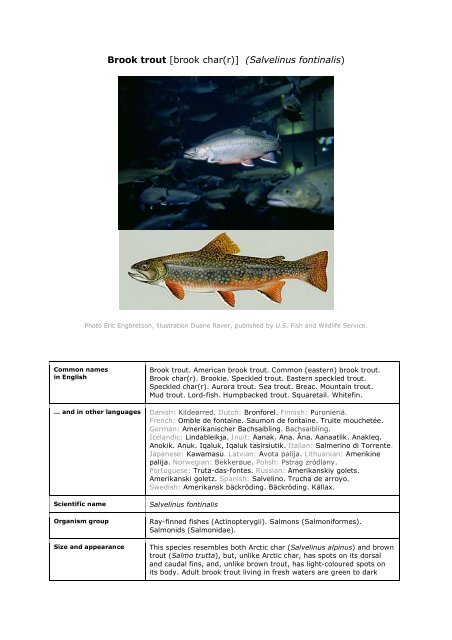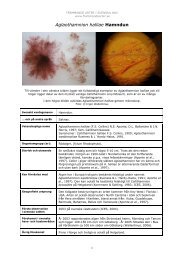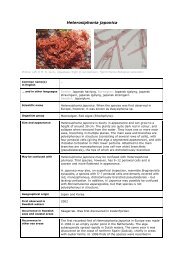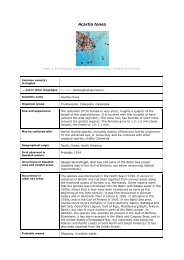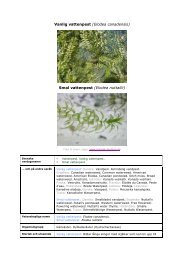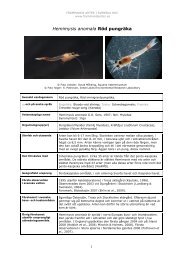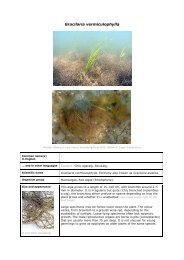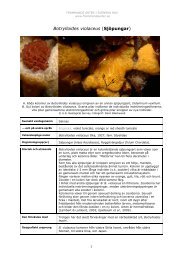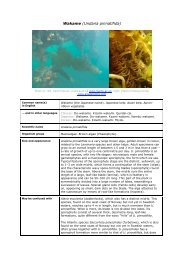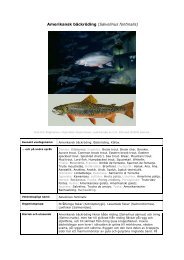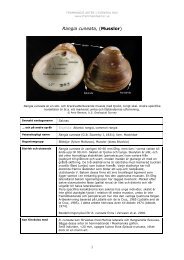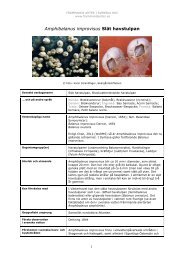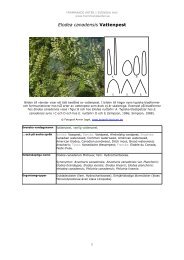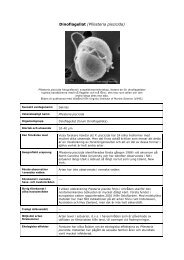Salvelinus fontinalis
Salvelinus fontinalis
Salvelinus fontinalis
You also want an ePaper? Increase the reach of your titles
YUMPU automatically turns print PDFs into web optimized ePapers that Google loves.
Common names<br />
in English<br />
Brook trout [brook char(r)] (<strong>Salvelinus</strong> <strong>fontinalis</strong>)<br />
Photo Eric Engbretson, lllustration Duane Raver, published by U.S. Fish and Wildlife Service.<br />
Brook trout. American brook trout. Common (eastern) brook trout.<br />
Brook char(r). Brookie. Speckled trout. Eastern speckled trout.<br />
Speckled char(r). Aurora trout. Sea trout. Breac. Mountain trout.<br />
Mud trout. Lord-fish. Humpbacked trout. Squaretail. Whitefin.<br />
… and in other languages Danish: Kildeørred. Dutch: Bronforel. Finnish: Puronieriä.<br />
French: Omble de fontaine. Saumon de fontaine. Truite mouchetée.<br />
German: Amerikanischer Bachsaibling. Bachsaibling.<br />
Icelandic: Lindableikja. Inuit: Aanak. Ana. Âna. Aanaatlik. Anakleq.<br />
Anokik. Anuk. Iqaluk, Iqaluk tasirsiutik. Italian: Salmerino di Torrente.<br />
Japanese: Kawamasu. Latvian: Avota palija. Lithuanian: Amerikine<br />
palija. Norwegian: Bekkerøue. Polish: Pstrag zródlany.<br />
Portuguese: Truta-das-fontes. Russian: Amerikanskiy golets.<br />
Amerikanski goletz. Spanish: Salvelino. Trucha de arroyo.<br />
Swedish: Amerikansk bäckröding. Bäckröding. Källax.<br />
Scientific name <strong>Salvelinus</strong> <strong>fontinalis</strong><br />
Organism group Ray-finned fishes (Actinopterygii). Salmons (Salmoniformes).<br />
Salmonids (Salmonidae).<br />
Size and appearance This species resembles both Arctic char (<strong>Salvelinus</strong> alpinus) and brown<br />
trout (Salmo trutta), but, unlike Arctic char, has spots on its dorsal<br />
and caudal fins, and, unlike brown trout, has light-coloured spots on<br />
its body. Adult brook trout living in fresh waters are green to dark
May be confused with –<br />
brown, almost black, on their back and sides. The back and upper<br />
sides have yellow and yellowish green worm-like markings or<br />
marbling. The lower part of the back has small yellow or yellowish<br />
green and/or red spots. The dorsal and caudal fins are a darker<br />
brownish green, while the other fins are reddish brown, often with a<br />
white and black border on the leading edge. During the spawning<br />
period, the colours are intensified, the belly of the male turning a<br />
characteristic deep orange-red.<br />
Brook trout sometimes migrate to the sea and remain there for a time<br />
before returning to fresh waters. Such fish are popularly known as<br />
“salters”. Adults in a saltwater environment have silvery sides, a dark<br />
blue or green back and a whitish belly. They may have pale red spots<br />
on the sides and on the white borders of their fins. On returning to<br />
fresh waters, they regain their earlier colours.<br />
Unlike Arctic char and lake trout (<strong>Salvelinus</strong> namaycush), brook trout<br />
rarely live for more than 9–10 years. Adults can grow to a length of<br />
about 80 cm, but usually reach just 30–45 cm. In Swedish waters,<br />
adult brook trout generally weigh just under 1 kg, although in fish<br />
farms they can reach a weight of 2–3 kg. In their native range, brook<br />
trout can be considerably larger, with a reported maximum weight of<br />
over 9 kg.<br />
Geographical origin Eastern North America: much of Canada, from Newfoundland to the<br />
western side of Hudson Bay; and in the United States, south through<br />
Massachusetts and along the Appalachians, and west to Minnesota.<br />
First observed in<br />
Swedish waters<br />
Occurrence in Swedish<br />
seas and coastal areas<br />
Occurrence in<br />
other sea areas<br />
Probable means<br />
of introduction<br />
Habitat(s) in which<br />
species occurs<br />
The species was first introduced into Sweden in 1892, for stocking in<br />
mountain waters.<br />
Brook trout that have escaped from fish farms have been caught in the<br />
Baltic off the Uppland coast. (The species may not be stocked in<br />
Swedish waters without a special permit.)<br />
Brook trout is a very popular species among anglers, and has<br />
consequently been introduced into countries throughout the world for<br />
stocking purposes. It was first imported to Europe in 1884, and is now<br />
to be found in natural and artificial waters across much of that<br />
continent, including the Nordic countries (Denmark, Finland, Norway<br />
and Sweden), the Baltic Sea area and the British Isles. The species has<br />
also been introduced into many other regions, including western North<br />
America, many countries in South America, Asia and Africa, and New<br />
Zealand and Australia.<br />
Aquaculture: cultivation and stocking.<br />
<strong>Salvelinus</strong> <strong>fontinalis</strong> requires an undisturbed environment, and can<br />
accordingly serve as a sensitive indicator of water pollution and<br />
oxygen depletion (it avoids cloudy water with low levels of oxygen).<br />
The species has become relatively tolerant of low pH, and adults can<br />
withstand pH levels as low as 5.0, but are unable to cope if the water<br />
becomes more acidic than that.<br />
The brook trout often lives alone in cold (preferably 10–18°C), clear,<br />
well-oxygenated rivers and small streams, but is also found in lakes<br />
together with many other fish species. It frequently swims in shallow<br />
water along the shoreline, but can be found at greater depths as well.
The species can also cope with warmer water, but in that case the<br />
water must be well oxygenated, with a temperature of 25°C at the<br />
very highest, and preferably no higher than 20°C. Brook trout are<br />
sometimes found in small ponds and springs. In Swedish freshwater<br />
systems where brown trout are also present, brook trout retreat to the<br />
headwaters of the system. In many cold lakes and watercourses in<br />
central and northern Sweden, the species lives in competition with<br />
brown trout. In its native range in North America, the brook trout<br />
shows considerable ecological similarities to the brown trout of Europe,<br />
spending its early years in tributary streams before becoming a lakedwelling<br />
predator, often feeding on Arctic char.<br />
In spring, brook trout may migrate between fresh waters and the sea,<br />
spending a short time (at most around three months) in the marine<br />
environment. These migrations are limited, however: the fish stay<br />
relatively close to river mouths, venturing no more than a few<br />
kilometres out to sea. Brook trout may run to the sea to avoid streams<br />
and rivers in which the water has become too warm, or because<br />
conditions have become unfavourable in some other respect<br />
(competition, a shortage of food). In some cases, they overwinter in<br />
estuaries and migrate along the coast. Migrations do not involve all the<br />
fish in a population, nor do they occur every year. Brook trout that do<br />
migrate, however, usually grow larger and live longer than strictly<br />
freshwater individuals.<br />
Brook trout feed on insects, worms, molluscs, crustaceans, amphibians<br />
and fish.<br />
Ecological effects In Swedish waters, the brook trout has established wild populations,<br />
often in small headwater streams, and may affect local populations of<br />
brown trout.<br />
Non-native salmonids that are stocked in Swedish waters may form<br />
hybrids with native species. Often these hybrids are fertile, which<br />
means that they are able to reproduce in the wild. This is true, for<br />
example, of “sparctic char” (also known as “sparctic trout” or “spar”, a<br />
cross between brook trout and Arctic char) and “splake” (brook trout<br />
and lake trout).<br />
The name splake comes from speckled trout + lake trout. This hybrid<br />
is also known as wendigo. The fact that sparctic char, splake, and the<br />
third hybrid combination, “larctic char” (a cross between lake trout and<br />
Arctic char), are able to reproduce naturally shows that <strong>Salvelinus</strong><br />
species may be involved in the active formation of new species.<br />
American studies have found that splake grow faster than brook trout,<br />
live longer, and often feed on fish (including pike) that could otherwise<br />
pose a threat to brook trout.<br />
In discussions about the genetic effects of non-native species finding<br />
their way into Swedish waters, the focus has been very much on<br />
salmonids, since such fish are farmed and stocked on a large scale<br />
and, what is more, hatchery-reared fish quite often escape into the<br />
wild.<br />
In this context, “genetic effects” means changes in the genetic makeup<br />
of native species that can result from the incorporation of genes<br />
from the new organisms. The risks associated with introducing nonnative<br />
populations or genes into the natural environment come under<br />
three main headings: extinction, hybridization, and loss of genetic<br />
variation.<br />
When closely related species or distinct populations of a single species
interbreed, hybridization can result. This can happen if individuals of a<br />
non-native species mate with individuals of a native one. The offspring<br />
exhibit characteristics differing, to a greater or lesser degree, from<br />
those of the native parent. In the long term, this may result in wild<br />
populations of a species losing some of their ability to adapt to their<br />
environment. Stocked fish, for example, are less well adapted to their<br />
new environment than the wild fish with which they mix.<br />
At worst, the introduction and spread of non-native populations or<br />
genes may drive native species to extinction. This may happen either<br />
because the native species is outcompeted and displaced, or because<br />
of genetic changes in the offspring (hybrid) of the alien and native<br />
species which mean that the offspring is unable to survive. If the<br />
hybrid is fertile, however, the next step may be an exchange of genes<br />
with the parent population. Non-native genetic material will then be<br />
incorporated into the native species, and in the long run the effect of<br />
this could be to eliminate local variants.<br />
Mixing of non-native species or genetic variants with local populations<br />
may have implications for Sweden’s populations of Arctic char, Atlantic<br />
salmon (Salmo salar) and brown trout. Over time, native salmonid<br />
stocks have adapted to conditions in their particular lakes and rivers,<br />
gradually becoming genetically distinct from every other stock of the<br />
same species. The loss of such local adaptations may leave a<br />
population less well equipped to survive.<br />
Stocking of hatchery-reared fish can also lead to inbreeding<br />
depression. This occurs when closely related individuals mate with one<br />
another, and may result in offspring that are unviable or have difficulty<br />
surviving.<br />
Other effects Brook trout is a very popular species among anglers, and is therefore<br />
of considerable economic significance. It is also a food fish, and is<br />
often sold across the fish counters of Stockholm as röding (“char”).<br />
Brook trout are cultured for use as pond fish, for direct sale as a food<br />
fish, and for stocking for recreational fisheries.<br />
FIND OUT MORE<br />
• North European and Baltic Network on Invasive Alien Species: <strong>Salvelinus</strong> <strong>fontinalis</strong><br />
http://www.nobanis.org/speciesInfo.asp?taxaID=700<br />
• Baltic Sea Alien Species Database: <strong>Salvelinus</strong> <strong>fontinalis</strong><br />
http://www.ku.lt/nemo/directory_details.php?sp_name=<strong>Salvelinus</strong>+<strong>fontinalis</strong><br />
• Alien species in Poland: Speckled brook trout<br />
http://www.iop.krakow.pl/ias/species.asp?198<br />
• ICES Working Group on Environmental Interactions of Mariculture<br />
http://www.ices.dk/iceswork/wgdetail.asp?wg=WGEIM<br />
• 125 kB: EU-kommissionen: A strategy for the sustainable development<br />
of European aquaculture<br />
http://www.europa.eu.int/eur-lex/en/com/cnc/2002/com2002_0511en01.pdf<br />
• 357 kB: EU-kommissionen: Farmed fish and welfare<br />
http://ec.europa.eu/fisheries/publications/farmedfish_en.pdf<br />
• Federation of Europan Aquaculture Producers<br />
http://www.feap.info/feap<br />
• European Aquaculture Society<br />
http://www.easonline.org<br />
• FishBase: <strong>Salvelinus</strong> <strong>fontinalis</strong><br />
http://www.fishbase.org/Summary/SpeciesSummary.php?id=246<br />
• European Nature Information System Database (EUNIS): <strong>Salvelinus</strong> <strong>fontinalis</strong><br />
http://eunis.eea.europa.eu/species-factsheet.jsp?idSpecies=9977&idSpeciesLink=9977<br />
• Ittiofauna.org: Il Salmonidi (webbplats om bl.a. laxfiskar i Europa)
http://www.ittiofauna.org/webmuseum/pesciossei/salmoniformes/salmonidae/salmonidae.htm<br />
• Alaska Department of Fish & Game: Brook trout<br />
http://www.adfg.state.ak.us/pubs/notebook/fish/b^trout.php<br />
• Nova Scotia Fisheries and Aquaculture: Speckled trout<br />
http://www.gov.ns.ca/nsaf/sportfishing/species/spec.shtml<br />
• University of Toronto: Brook trout<br />
http://www.zoo.utoronto.ca/manuesteve/UTbrooktrout.html<br />
• Ontario Federation of Anglers and Hunters: Ontario's fish: Brook trout<br />
http://www.ofah.org/fishing/description.cfm?Species=Cold_Water&FishID=18<br />
• Canadian Sportfishing: Brook trout<br />
http://www.canadian-sportfishing.com/Tips&Techniques/Species_Info/Default1.asp?Species_Name=BROOK TROUT<br />
• Trout unlimited: Back the Brookie<br />
http://www.brookie.org<br />
• U.S. Fish and Wildlife Service: Coaster brook trout<br />
http://www.fws.gov/midwest/Fisheries/topic-coasterbrooktrout.htm<br />
• U.S. Fish and Wildlife Service: Brook trout<br />
http://images.fws.gov/default.cfm?CFID=5641494&CFTOKEN=95949698<br />
• National Wildlife Foundation: <strong>Salvelinus</strong> <strong>fontinalis</strong><br />
http://www.enature.com/fieldguides/detail.asp?shapeID=994&curGroupID=3&lgfromWhere=&curPageNum=15<br />
• Mt. Baker-Snoqualmie National Forest Pacific Northwest Fisheries Program:<br />
Eastern Brook Trout<br />
http://www.fs.fed.us/r6/fishing/forests/fishresources/mtbsno_coldwater.html#eastbrook<br />
• Wisconsin Sea Grant: Brook trout<br />
http://www.seagrant.wisc.edu/greatlakesfish/brooktrout.html<br />
• Virginia Fish and Wildlife Information Service: Virtual Aquarium: <strong>Salvelinus</strong> <strong>fontinalis</strong><br />
http://www.cnr.vt.edu/efish/families/brktrout.html<br />
• US Geological Survey: NAS-Nonindigenous Aquatic Species: <strong>Salvelinus</strong> <strong>fontinalis</strong><br />
http://nas.er.usgs.gov/queries/FactSheet.asp?speciesID=939<br />
• Cornell University: Fishes of New York: Brook trout<br />
http://fish.dnr.cornell.edu/nyfish/Salmonidae/brook_trout.html<br />
• NatureServe Explorer: <strong>Salvelinus</strong> <strong>fontinalis</strong><br />
http://www.natureserve.org/explorer/servlet/NatureServe?searchName=<strong>Salvelinus</strong> <strong>fontinalis</strong><br />
• Trouts and Seasons of The Mountain Village: <strong>Salvelinus</strong> <strong>fontinalis</strong><br />
http://www.amago.jp.lv/trout/trout32.html<br />
Splake<br />
• US Geological Survey: NAS-Nonindigenous Aquatic Species: <strong>Salvelinus</strong> <strong>fontinalis</strong> x namaycush<br />
http://nas.er.usgs.gov/queries/FactSheet.asp?speciesID=940<br />
• Ontario Federation of Anglers and Hunters: Ontario's fish: Splake<br />
http://www.ofah.org/fishing/description.cfm?Species=Cold_Water&FishID=24<br />
• State of Maine: Splake Fact Sheet<br />
http://www.state.me.us/ifw/fishing/fishidentification/splake.htm<br />
• Wisconsin Department of Natural Resources: Lake Trout--Splake--"Coaster" Brook Trout comparison<br />
http://www.dnr.state.wi.us/org/gmu/superior/Fish/Fish ID.htm<br />
Photo: Eric Engbretson<br />
Illustration: Duane Raver<br />
IMAGES CREDITS<br />
Images are published under public domain by U.S. Fish and Wildlife Service, Digital Library<br />
Service<br />
http://images.fws.gov<br />
• This factsheet on <strong>Salvelinus</strong> <strong>fontinalis</strong> was created on 30 November 2006<br />
• First update: 15 January 2007<br />
• Translated by Martin Naylor on 22 January 2007


